Abstract
Machinery with several rotating and stationary components tends to produce non-stationary and random vibration signatures due to the fluctuations in the input loads and process defects due to long hours of operation. Traditional heuristics methods are suitable for the detection of fault signatures, however, they become more complicated when the level of uncertainty or randomness exceeds beyond control. A novel methodology to identify these fault signatures using optimal filtering of vibration data is proposed to eliminate any false alarms and is expected to provide a higher probability of correct diagnosis. In this paper, a detailed pipeline of the algorithms are presented along with the results of the investigation that was carried out. These investigations are performed using open-source vibration data published by the NASA prognostics centre. The performance of these algorithms are evaluated based on the ground truth results published by NASA researchers. Based on the performance of these algorithms several parameters are fine-tuned to ensure generalisation and reliable performance.
1. Introduction
Statistical process control has been extensively used for condition monitoring of industrial machinery. Vibration-based condition monitoring is considered a primary tool for performing necessary day-to-day inspections as this is a non-invasive procedure. Vibration data from rotating machinery has multiple frequency components. For rotating machinery which involves oil lubricant fluid interaction, the complexity of the frequency combinations is higher. Usually, abnormal patterns in the vibration data indicate an abnormal behaviour that might cause issues to either the process or the processing equipment. These abnormal patterns generate non-stationary components that are buried in time-series vibration signals and are difficult to extract [1]. Given this challenge, there is a need to develop efficient algorithms to identify abnormal vibration patterns and label the cause of the defect.
Number of researchers have developed algorithms to automate the detection of an abnormal pattern from the normal raw vibration pattern. Automating the detection process is crucial in these situations as the source of the vibration patterns and the process through which they mix is unknown. In multiple situations, it is very useful to identify the individual sources of each frequency components, either to eliminate obvious frequency components which do not represent the defect or to verify the output performance with known inputs.
Many diverse algorithms are developed to tackle the Blind Source Separation (BSS) problem, and these algorithms are developed based on higher-order statistical features as they are suitable to recognise Non-Gaussian signals from Gaussian ones. Other techniques such as Entropy Minimisation (EM) and Minimal Mutual Information (MMI) are suitable to solve a BSS problem [2]. BSS can also be used for image separation for pulse thermography detection in detecting debonding defects of solid propellant rocket motor cladding layer [3].
Independent Component Analysis (ISA) is another popular choice to tackle the BSS problem, and it is used to extract features such as modal parameters and singular values for machine fault [4,5,6]. In addition, Pelegrino et al. [7] have implemented a combination of ICA and Support Vector Machine (SVM) technique for concurrent control charts pattern recognition for industrial process monitoring. Deep learning approach such as Neural Network (NN) is often used to perform feature extraction algorithms due to their self-learning process to realise different features. This is also proven to be a promising technique to solve the BSS problem. Liu et al. [8] have proposed a NN with bias term and maximum likelihood estimation criterion technique to improve the convergence speed of source separation performance that most BSS algorithms suffer from. It is validated with actual data recorded in a real ship’s engine room to separate the key component frequencies and the result proves its effectiveness in practical engineering applications. However, the NN approach has limitations that require a large amount of data to achieve good accuracy and the transferability is limited to a specific application. The amount of time to train a model is also demanding. To summarise the fundamental approach of BSS, Pal et al. [9] have categorised this into four types as listed below:
- Non-stationary, Time-varying variances;
- Time-Frequency, Spectral/Spatial diversities;
- Temporal Structure, Non-Whiteness;
- Mutual Independence, Non-Gaussianity and ICA
Spectral Kurtosis (SK) is a statistical spectral analysis technique that can be used to characterise non-stationary time signals. This is based on spectral analysis of the time series analysis Kurtosis and is an enhancement to the classic power spectrum density (PSD). It is capable of detecting non-stationary components in noisy transient signals by finding a closed-form relationship in regard to signal-to-noise ratio [10]. Therefore, in this paper we report the investigation that was carried out in utilising SK based BSS method for damage detection in an asset monitoring application.
Randall and Antoni reported the theory of Spectral Kurtosis and applied this technique to detect rolling element bearing defects using a statistical thresholding approach [11]. Wang and Liang introduced the adaptive spectral kurtosis (ASK) method for the characterisation of rolling element bearing faults [12]. To obtain an optimal filter, Combet and Gelman [13] proposed a technique based on the adaptive thresholding procedure applied to the SK estimate. As an alternative to the STFT, Gelman et al. [14] estimated SK using the variable resolution wavelet transform and applied wavelet spectral kurtosis for the diagnosis of gearbox defects. Liu et al. [15] introduced the wavelet adaptive SK filtering technique for the diagnosis of gearbox tooth faults. However, few gaps listed below remain unsolved.List of unsolved problems or gaps in literature Numbered lists can be added as follows:
- Spikes in signals increase in SK significantly
- Spikes in rolling element bearing vibration data are quite frequent.
- Scalability of the SK data analysis pipeline
- Previously reported approaches are applicable to few sets of datasets and cannot be generalised to other machinery data sets.
- Higher noise in signals can cause errors in SK
- The low SNR in acceleration signals causes false alarms in the signals and feature engineering failures.
The use of the spike subtraction, stationary wavelet transforms, and automated change detection were not addressed by the previous authors. The spike subtraction algorithm restores each data point of the vector by its median estimated over a fixed window length. Accordingly, median filtering ensures all the outliers are eliminated. By implementing the spike subtraction false alarms are significantly minimised which provides a reliable feature engineering tool. Each spike which is not correlated to the defect will cause the SK to produce a peak which will add noise to the SK spectrum. The wavelet transforms–based decomposition proposed in the later section of this paper will ensure the signal to noise ratio is high and increases the probability of correct diagnosis. Combination of these algorithms make the SK based approach more reliable and easier to adapt in an industrial setting. These algorithms improve the scalability of the proposed SK based defect detection pipeline. In addition, the change detection algorithm proposed provides a fool proof method for data visualisation and enables early diagnosis of bearing defects. This pipeline can be generalised and is adaptable to other rotating machinery such as gearboxes and structures with bolt looseness [16].
In general, bearing defects are localised to either the outer race, inner race or the cage of the support. When a bearing strikes a local defect (e.g., pitting due to wear), impulse excitation is observed. The impulse excitation (narrowband excitation) tends to excite the resonance of the bearing structure, which generates an impulse response.
The technique that was was utilised is the blind source separation method involving Spectral Kurtosis based Weiner filtering. The results presented demonstrate an early bearing fault detection method developed using the vibration data. The raw vibration data is a combination of excitation from multiple individual vibration sources, the fault signature is masked with a weak signature.
This paper consists of four sections. The detail of experiments and data acquisition is presented in Section 2. The proposed methodology is described in Section 3 explains the pre–processing algorithms and the SK–based blind feature extraction algorithm along with the performance. The conclusion and future work is presented in Section 4.
2. Description of the Experiments and Data Acquisition
The data used in this paper is open–source vibration data published by the NASA prognostics centre for experiments on bearings [17]. This dataset has been utilised by many researchers to validate their proposed techniques. A detailed comparison of the summary of findings published in literature with the proposed method are presented in the Table 1. Qiu et al. [18] and Wang et al. [19] have developed a weak signature detection method using wavelet–transform. Yu [20] has taken a different approach to utilise hidden Markov model to filter the damage sensitive coefficients and used dynamic principle component analysis to decompose the signal. These algorithms can detect defects and no prior knowledge to failures are required, Qiu et al. [18] have implemented a de–noising process using wavelet transform. They managed to detect the defect pattern on day 27 which is a week earlier than the final run to failure inspection day. The trend forecast developed by Wang et al. [19] can be easily affected by noise and false alarm are quite possible as the empirical method retrieved from the 10th IMF (Intrinsic Mode Function) from EMD resulting in a coarse result.

Table 1.
Comparison of signal processing technniques using the NASA IMS bearing data.
The test setup consists of four Rexnord ZA–2115 double row bearings installed on a shaft as shown in Figure 1. The AC motor coupled to the shaft was set to rotate at a constant speed of 2000 RPM via rub belts. A spring mechanism was used to apply a radial load of 2721.55 kg on the shaft and bearing to accelerate the deterioration process.
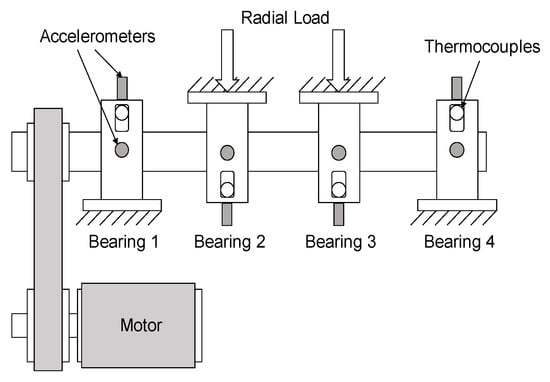
Figure 1.
IMS bearing test set up and sensor’s configuration.
Four pairs of PCB 353B33 accelerometers were installed to capture the x- and y-axes vibration response of the four bearings. The sensor displacement is presented in Figure 1. All data set consists of individual files of a one second duration of vibration signal measurements with 20,480 data points sampled at 20 kHz. The measurement interval is set to every ten minutes. The experiments are conducted until the failures occurred after exceeding the designed lifetime of the bearing that is more than 100 million revolutions.
3. Proposed Signal Processing Methodology
The proposed algorithm consists of two stages; firstly it implements pre-processing of raw data for the de–noising purpose and followed by blind feature extraction for defect detection. The pre–processing algorithm is implemented by eliminating spikes in data which could make extracting features difficult due to the fluctuation. After the initial cleaning process, the second stage of feature extraction algorithm using the proposed BSS technique is performed to detect damage sensitive features.
3.1. Pre-Processing Algorithms
Spikes from data that may have been caused due to random events and fluctuations do not represent any defects; this event may occur due to electrical noise, it is recommended to remove the noise components that mask the defect patterns in the signal. Two pre–processing functions are developed to ensure the data is clean before features extraction. The description of these operations is presented below.
3.1.1. Spike Subtraction Algorithm for Detection of Abnormal Events
The spike subtraction algorithm restores each data point of the vector by its median estimated over a fixed window length. Accordingly, median filtering ensures all the outliers are eliminated. The performance of the spike subtraction algorithm is presented in Figure 2. Despite there are spikes subtracted (arrows), there are still lots of noise buried in the signal. Therefore, an appropriate de–noising algorithm is required to improve the signal–to–noise (SNR) ratio that is discussed in the next section.
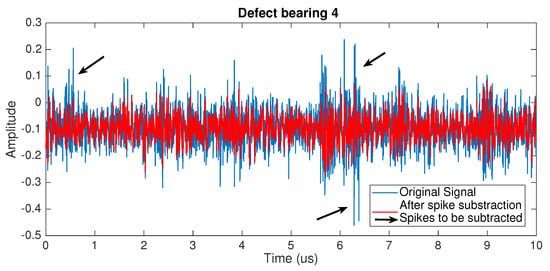
Figure 2.
Demonstration of spike subtraction algorithm on open source IMS bearing data set.
3.1.2. Wavelet Decomposition
The next phase of pre–processing algorithms is developed to extract signal patterns that are buried inside the noise. For data with higher sampling rates, the noise floor will be significant. This noise is eliminated by stationary wavelet decomposition. Stationary Wavelet Transform (SWT) is a variant of Discrete Wavelet Transform (DWT). This allows for better time–frequency localisation as the number of wavelets sampled can be used to locate a particular temporal interval within data, creating a logarithmic frequency scale.
Different types of wavelet can be sampled in the transform and each wavelet has different characteristics that can change how the transformation of the data is applied. This new representation retains important information about the data whilst compresses it. Overall, the signal was demonstrably smoothened more than the spike subtraction signal in the previous stage. SWT completely removed the noise as shown in Figure 3.
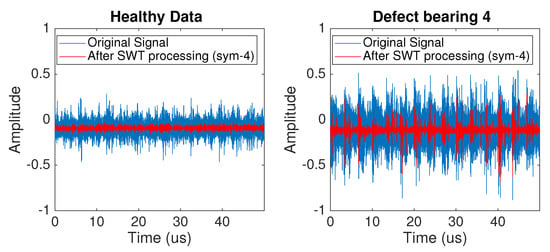
Figure 3.
Before and after de–noising using Stationary Wavelet Transform.
In addition to the time serise analysis, a exploratory processing task utilising power spectral density (PSD) to compare the spectra of signal before and after denoising using SWT based pre-processing methods is also implemented. The resulting figures are presented in Figure 4. As it is event from the plots, the PSD estimates has dropped significant energy of at least 20 dB&/Hz after 1 kHz in both healthy and defect data. Moreover, the noise buried in the SWT processed health data has become neglectable between 1 kHz and 9 kHz. This shows that the noise is completely eliminated.
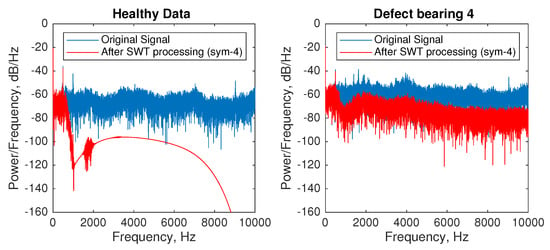
Figure 4.
PSD estimate of before and after denoising using Stationary Wavelet Transform.
3.2. Feature Extraction Algorithms
Faults in rotating machinery such as bearings, tend to produce weak vibration signatures in the data. These weak signatures can tend to create cyclo–stationary random components as shown in Figure 5. These signals are hidden inside the raw data with other signal components. Other vibration components include input shaft frequencies and higher–order harmonics due to load fluctuations. The aim of the blind feature extraction technique proposed in this study is to extract these weak signatures from the signals. These weak signatures are non-stationary components in the signal and can excite resonance frequencies of the bearing because of the cyclic behaviour.

Figure 5.
(Left) Bearing configuration with rolling elements (left) [21]. (Right) Signal expected due to bearing fault.
SK Based Blind Feature Extraction Algorithm
Spectral Kurtosis (SK) is a technique that can be used to extract non–stationary frequency components concealed in time–series signal. It is capable of realising the non-stationary characteristic of a signal while suppressing Gaussian noise and stationary components utilising its Kurtosis statistical parameter. Researchers have showed interests in using this technique due to its performance in detecting non-stationary components generated by the defect. For instance, most of the applications are focused on damage detection of rotating machines in respect to bearing faults [22,23].
SK was initially used as a supplementary tool to PSD for detecting arbitrary frequency in a signal which cannot be displayed by Fourier Transform. However, it was rarely been used due to the lack of theoretical proof. Antoni was one of the first to publish the mathematical approach to assemble the missing theory background of SK. It is also validated with applications in vibration-based condition monitoring [11]. SK can be estimated using the signal–to–noise (SNR) ratio of the detected transients buried in noisy signals. Consider a vibration signal, , SK can be calculated using Equation (1) based on the second () and fourth () spectral moments of the signal.
The spectral moment can be estimated according to Equation (2),
where is Fourier power spectrum of the signal, .
An SK–based Wiener filter is derived using the processed SK estimates with a statistical threshold. This adaptive threshold is selected using the maximum value of the SK estimates in order to ease the need of baseline data. In this study at a 20% threshold on the maximum value of the SK, the estimate is considered. The approach is demonstrated and validated here. The methodology is presented in Figure 6.

Figure 6.
Spectral Kurtosis Feature extraction and filtering methodology, steps 1 is described in Section 3.2.
The pre–processed data shown in Figure 3, demonstrates how the pattern buried inside the raw vibration data can be extracted. It is used as input to the SK based filtering function which computes the spectral kurtosis of the data. The spectral kurtosis can either be estimated using a Fast Fourier Transform (FFT) Algorithm or by using time–frequency techniques such as the Short–Time Fourier Transform (STFT). The advantage offered by STFT based SK estimate is that this approach can address non-stationary signals better than FFT, i.e., by considering windows. The SK estimate is presented in Figure 7. Two signals from the healthy and defect data sets are used to realise this diagram, later the feature estimate of all 2156 signals is presented.
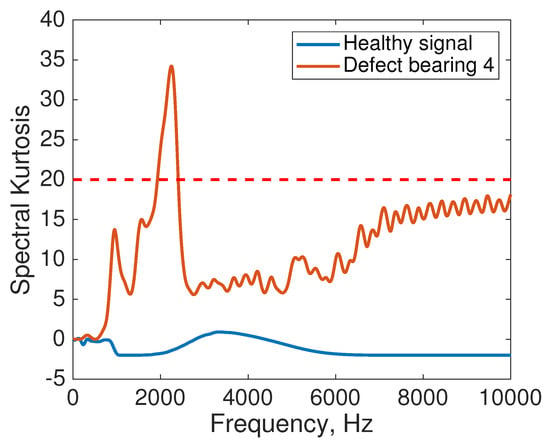
Figure 7.
Spectral Kurtosis Estimate for signal 10 and 2100, healthy and defect.
The SK based Weiner filter extracted by threshold filter is presented in Figure 8. It is evident from this plot that the Weiner filter for healthy bearing has no significant peak which corresponds to the non-stationary behaviour in the signal. However, for the defect bearing signal, a significant peak is observed. For multiple signals, manual data processing is performed to cross–validate the results obtained with the ground truth results published by the NASA authors [18].
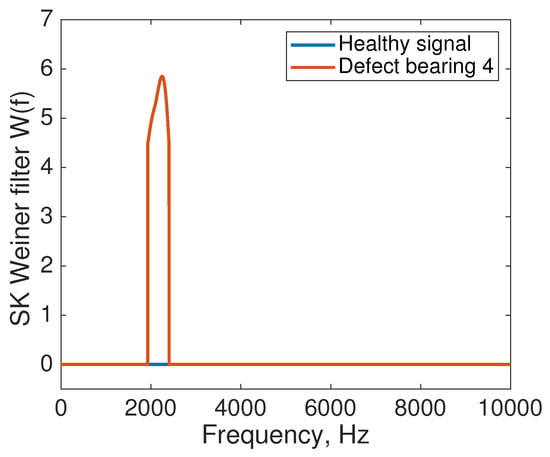
Figure 8.
SK –based wiener filter extracted from SK curve through thresholding at 20 units.
The Weiner filter is applied to the raw data for extracting the defect vibration data and once the signal is obtained, Hilbert Transform is used to extract the envelopes of the signal component. The envelope for a defect and unhealthy bearing data set is presented in Figure 9. Evidence of the rolling element bearings hitting the outer race periodically is observed. For the healthy case, no non–stationary vibration components are seen which indicates the diagnosis is successful.
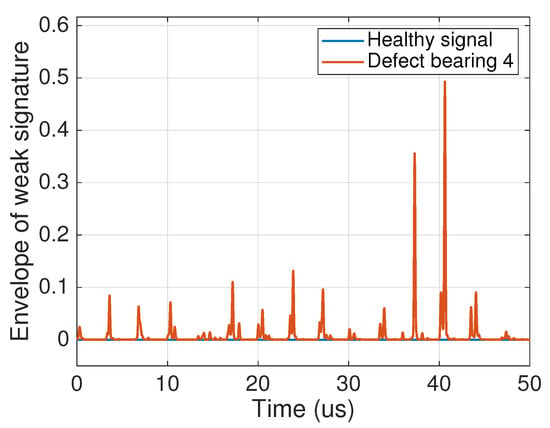
Figure 9.
Envelope of the SK filtered signal.
For the IMS bearing data set with 2156 signal samples, the SK feature estimate is presented in Figure 10 below. It is evident that the SK based feature extraction clearly detects the faults and any other non-stationary behaviour in the data.
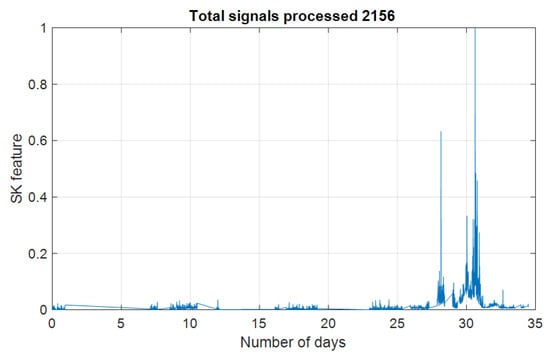
Figure 10.
SK feature for all signals plotted against the number of days of testing.
The decision boundary is extracted using the change detection algorithm. From the change detection algorithm, it is identified that bearing 4 has been damaged on day 27 as shown in Figure 11, which is a week earlier than the final run to failure inspection day. Thus, the proposed approach has the potential to identify early fault characteristics.
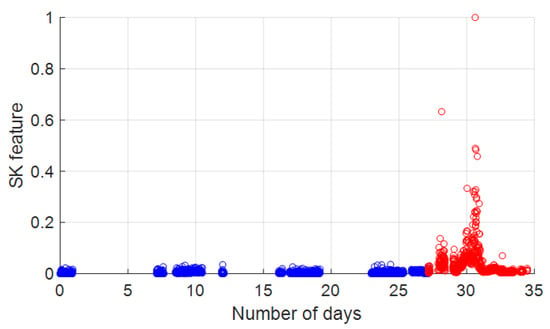
Figure 11.
SK features vector after application of change detection algorithm.
4. Conclusions and Future Work
Early detection for asset monitoring is critical for efficient maintenance scheduling to save cost and preserve the quality of industrial process and outcome. In this study, a Blind Source Separation method utilising Spectral Kurtosis based Weiner filtering was implemented. Results indicate that the proposed approach can be reliable and effective in detecting bearing faults for early fault diagnosis. Given the promising result of the proposed technique, the authors will explore using the extracted feature as input to machine learning model such as SVM and neural network to develop an automated asset monitoring application. Indeed, machine learning techniques are very powerful in automating the thresholding based on labelled data which will allow achieving both early and automated detection of defects.
Author Contributions
Conceptualization, S.K.H. and H.C.N.; investigation and methodology, S.K.H. and H.C.N.; validation, S.K.H. and H.C.N.; data analysis, S.K.H. and H.C.N.; writing—original draft preparation, S.K.H.; writing—review and editing, S.K.H., H.C.N., W.B., J.K. and T.-H.G.; visualization, S.K.H.; supervision, W.B. and T.-H.G.; project administration, H.C.N. All authors have read and agreed to the published version of the manuscript.
Funding
This research was funded by the UK’s innovation agency, Innovate UK under grant agreement number 104505.
Institutional Review Board Statement
Not applicable.
Informed Consent Statement
Not applicable.
Data Availability Statement
Publicly available datasets were analyzed in this study. This data can be found here: [https://ti.arc.nasa.gov/tech/dash/groups/pcoe/prognostic-data-repository/#bearing, accessed on 1 February 2021].
Acknowledgments
The research has been undertaken as a part of the project entitled “Artificial intelligence-based digital prescriptive maintenance of ships (DiMOS)”. The DiMOS project is a collaboration between the following organisations: VibteK Ltd., CMS services UK Ltd., TWI Ltd., and Brunel University London.
Conflicts of Interest
The authors declare no conflict of interest.
References
- Kumar, A.; Gandhi, C.P.; Zhou, Y.; Kumar, R.; Xiang, J. Latest developments in gear defect diagnosis and prognosis: A review. Meas. J. Int. Meas. Confed. 2020, 158, 107735. [Google Scholar] [CrossRef]
- Yang, H.H.; Amari, S.I. Adaptive Online Learning Algorithms for Blind Separation: Maximum Entropy and Minimum Mutual Information. Neural Comput. 1997, 9, 1457–1482. [Google Scholar] [CrossRef]
- Wang, F.; Liu, J.; Dong, B.; Gong, J.; Peng, W.; Wang, Y.; Chen, M.; Liu, G. Blind image separation for the debonding defects recognition of the solid propellant rocket motor cladding layer using pulse thermography. Meas. J. Int. Meas. Confed. 2021, 174, 108997. [Google Scholar] [CrossRef]
- Li, X.; Antoni, J.; Brennan, M.J.; Yang, T.; Liu, Z. A frequency domain blind identification method for operational modal analysis using a limited number of sensors. JVC/J. Vib. Control. 2020, 26, 1383–1398. [Google Scholar] [CrossRef]
- Li, H.; Tan, Y.; Pu, Y. Blind Information Extraction of Machine Faults Based on Separating Matrix. In Proceedings of the 2020 IEEE 5th International Conference on Intelligent Transportation Engineering, ICITE 2020, Beijing, China, 11–13 September 2020; pp. 301–305. [Google Scholar] [CrossRef]
- Li, Z.; Yan, X.; Tian, Z.; Yuan, C.; Peng, Z.; Li, L. Blind vibration component separation and nonlinear feature extraction applied to the nonstationary vibration signals for the gearbox multi-fault diagnosis. Meas. J. Int. Meas. Confed. 2013, 46, 259–271. [Google Scholar] [CrossRef]
- Pelegrina, G.D.; Duarte, L.T.; Jutten, C. Blind source separation and feature extraction in concurrent control charts pattern recognition: Novel analyses and a comparison of different methods. Comput. Ind. Eng. 2016, 92, 105–114. [Google Scholar] [CrossRef] [Green Version]
- Liu, S.; Wang, B.; Zhang, L. Blind source separation method based on neural network with bias term and maximum likelihood estimation criterion. Sensors 2021, 21, 973. [Google Scholar] [CrossRef] [PubMed]
- Pal, M.; Roy, R.; Basu, J.; Bepari, M.S. Blind source separation: A review and analysis. In Proceedings of the 2013 International Conference Oriental COCOSDA Held Jointly with 2013 Conference on Asian Spoken Language Research and Evaluation, O-COCOSDA/CASLRE 2013, Gurgaon, India, 25–27 November 2013. [Google Scholar] [CrossRef]
- Valeriu, V.; Granjon, P.; Servière, C. Spectral Kurtosis: From Definition To Application. In Proceedings of the IEEE-EURASIP Workshop on Nonlinear Signal and Image Processing, Grado-Trieste, Italy, 8–11 June 2003. [Google Scholar]
- Antoni, J. The spectral kurtosis: A useful tool for characterising non-stationary signals. Mech. Syst. Signal Process. 2006, 20, 282–307. [Google Scholar] [CrossRef]
- Wang, Y.; Liang, M. Identification of multiple transient faults based on the adaptive spectral kurtosis method. J. Sound Vib. 2012, 331, 470–486. [Google Scholar] [CrossRef]
- Combet, F.; Gelman, L.; Lapayne, G. Novel detection of local tooth damage in gears by the wavelet bicoherence. Mech. Syst. Signal Process. 2012, 26, 218–228. [Google Scholar] [CrossRef]
- Gelman, L.; Harish Chandra, N.; Kurosz, R.; Pellicano, F.; Barbieri, M.; Zippo, A. Novel spectral kurtosis technology for adaptive vibration condition monitoring of multi-stage gearboxes. Insight-Non-Destr. Test. Cond. Monit. 2016, 58, 409–416. [Google Scholar] [CrossRef]
- Liu, H.; Huang, W.; Wang, S.; Zhu, Z. Adaptive spectral kurtosis filtering based on Morlet wavelet and its application for signal transients detection. Signal Process. 2014, 96, 118–124. [Google Scholar] [CrossRef]
- Ho, S.K.; Nedunuri, H.C.; Balachandran, W.; Gan, T.H. Bolt looseness detection using Spectral Kurtosis analysis for structural health monitoring. In Proceedings of the ISMA2020 and USD2020, Leuven, Belgium, 7–9 September 2020; pp. 1215–1221. [Google Scholar]
- Lee, J.; Qiu, H.; Yu, G.; Lin, J.; Rexnord Technical Services. IMS, University of Cincinnati. “Bearing Data Set”, NASA Ames Prognostics Data Repository; NASA Ames Research Center: Moffett Field, CA, USA, 2007. Available online: http://ti.arc.nasa.gov/project/prognostic-data-repository (accessed on 4 May 2021).
- Qiu, H.; Lee, J.; Lin, J.; Yu, G. Wavelet filter-based weak signature detection method and its application on rolling element bearing prognostics. J. Sound Vib. 2006, 289, 1066–1090. [Google Scholar] [CrossRef]
- Wang, F.; Zhang, Y.; Zhang, B.; Su, W. Application of wavelet packet sample entropy in the forecast of rolling element bearing fault trend. In Proceedings of the 2011 International Conference on Multimedia and Signal Processing, CMSP 2011, Guilin, China, 14–15 May 2011; Volume 2, pp. 12–16. [Google Scholar] [CrossRef]
- Yu, J. Health condition monitoring of machines based on hidden markov model and contribution analysis. IEEE Trans. Instrum. Meas. 2012, 61, 2200–2211. [Google Scholar] [CrossRef]
- Rolling Element Bearing Fault Diagnosis—MATLAB & Simulink—MathWorks United Kingdom. Available online: https://uk.mathworks.com/help/predmaint/ug/Rolling-Element-Bearing-Fault-Diagnosis.html (accessed on 27 March 2021).
- Osorio Santander, E.J.; Silva Neto, S.F.; Vaz, L.A.; Monteiro, U.A. Using spectral kurtosis for selection of the frequency bandwidth containing the fault signature in rolling bearings. Mar. Syst. Ocean. Technol. 2020, 15, 243–252. [Google Scholar] [CrossRef]
- Wang, Y.; Xiang, J.; Markert, R.; Liang, M. Spectral kurtosis for fault detection, diagnosis and prognostics of rotating machines: A review with applications. Mech. Syst. Signal Process. 2016, 66–67, 679–698. [Google Scholar] [CrossRef]
Publisher’s Note: MDPI stays neutral with regard to jurisdictional claims in published maps and institutional affiliations. |
© 2021 by the authors. Licensee MDPI, Basel, Switzerland. This article is an open access article distributed under the terms and conditions of the Creative Commons Attribution (CC BY) license (https://creativecommons.org/licenses/by/4.0/).